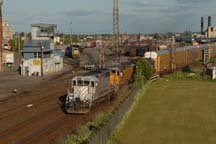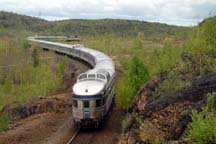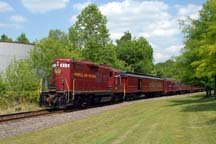All the images from this trip can be viewed in Photologues. Use the link at left.
The National Railway Historical Society held its 2006 Convention in New Philadelphia, Ohio, from July 18-22. I was joined by my brother Bruce and we headed for Ohio to check out the event, plus do some railfanning along two interesting Ohio shortlines, the Ohio Central (which would host three of the Convention trips) and the Wheeling & Lake Erie.
July 15, 2006
We left New Jersey in the morning, making a stop along Amtrak's ex-Pennsylvania Railroad main line at Christiana to get a Keystone service passenger train passing the freight house that has been restored by the Lancaster Chapter NRHS. Just before the train's arrival, a heavy rain swept through, and my auto-focus camera focused on the raindrops for my telephoto shot of the eastbound -- it made for an interesting image. The camera recovered in time to get a properly-focused shot at a normal focal length.
This day had the real potential to have nothing happen. We decided to make a run for Horseshoe Curve near Altoona, Pennsylvania, arriving there in mid-afternoon (for being the area's biggest tourist attraction, there are amazingly few signs pointing to the Curve). A westbound freight was sitting in Altoona as we passed through, and I thought this might be the first train we'd see at the Curve.
Boy, was I wrong! There was a constant parade of trains in both directions on this piece of Norfolk Southern's ex-Pennsy main. As soon as one train would clear, another would appear, and we even had trains passing each other on the curve in front of us. A slightly late westbound
Pennsylvanian brought an end to our time at the Curve a little after 5:00 p.m.

The morning rain had yielded to afternoon clouds, and it wasn't long after our arrival at the Curve that the sun started to make an appearance. In fact, the vast majority of the trains we shot at the Curve were in sun. With plenty of sun left, we ventured into downtown Altoona and Alto Tower, one of the last manned interlockings on the former Pennsylvania Railroad. We weren't there long before a downhill (eastbound) train passed an uphill (westbound) train, with rear-end helpers on both trains passing in front of the tower.

From Altoona we headed down to Duncansville to check out the Everett Railroad, where we found three locomotives in the sun. Finally it was off to the summit of the Alleghenies at Gallitzin to shoot trains coming out of the tunnel there. The sun was almost shining directly down the tracks, allowing for shooting trains with sun on them while they were still inside the tunnel. The day ended at the helper station at Cresson before we headed to Wheeling for the night.
July 16, 2006
The hard part about railfanning the Ohio Central and Wheeling & Lake Erie is finding trains. We started the morning in Mingo Junction, Ohio, where we made a quick check of the Norfolk Southeern yard. Not much happening, so we headed west along the Wheeling & Lake Erie to where it shares track with the Ohio Central between Jewett and Bowerston, Ohio. A W&LE light power set was at the east end of the joint track at Jewett, ready to head east on the OC, sso we chased the units to Miller's Station where they proceeded down to the Nelms No.1 coal mine.
Continuing our drive along the OC and W&LE, we found nothing happening anywhere, so we headed for Brewster, home of the W&LE shops and dispatching offices. Here we found out that there were a couple of trains working between Brewster and Hartland Station, so off we went in search of them. At Creston the W&LE parallels CSX's ex-Baltimore & Ohio main line, so we decided to wait there for the W&LE to send an eastbound. We were rewarded with a CSX westbound during our wait, then the eastbound (with a blue EMD leaser on the point) arrived. We shot it just outside Orrville, and from there the roads and the tracks work on diagonals with each other, making chasing quite difficult.
We thought there was a second train on the way, so we went back to Creston where a CSX hi-rail truck was heading west. We camped out between the CSX and W&LE grade crossings in town, and soon a W&LE hi-rail truck headed east. Our second train was a pick-up truck. Dang! We decided to head back into Brewster to see what was happening there, but as we passed near Orrville we heard our first train just finishing work at Orrville Junction, so we tried to give chase. We just missed it, however, at two well-lit locations, but heard a westbound leaving Orrville Junction. We quickly reversed direction and headed for Lodi where we were relieved to hear the train switching just east of our location between Lodi and Creston. Good! It had been a couple of hours since we took our last picture (and here it was pushing 5:00 p.m. and we had seen only one moving train all day!).
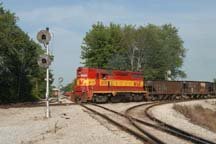
We headed for Spencer, Ohio, where the W&LE has a diamond and heads in four different directions. Our train showed up at Spencer with one of two high-nosed GP38s in the Wheeling red and yellow in the lead, and a locomotive in the W&LE's Rio Grande-style speed lettering tagging along on the rear. We chased the train to Hartland Station, catching it a couple of times on the way. After switching at Hartland, it headed westward and we decided to drop down to the CSX main line at Nova to see what was happening.
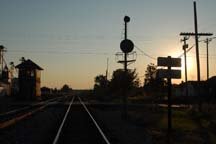
Still standing at Nova is an unused wood-frame Baltimore & Ohio tower, and we hoped for a westbound train before the sun set. Alas, the train showed up just after sunset, but we were able to get pleenty of glinty light images of the tower before calling it a day. It had been a slow morning and afternoon, but the evening was worthwhile.
July 17, 2006
We actually had some "insider" information on the Wheeling's operations on this day, and our source told us that a westbound would be out of Mingo Junction in mid-morning. We headed for the big trestle at Valley View, but according to our calculations it would be close. We got to the trestle at about 11:00 (the train was departing Mingo at 10:30) and waited. And waited. Did we miss the train?
We heard a track foreman get permission to work between milepost 105 and Smithfield, just west of our location. Sadly, we figured our train must have gotten by us and had passed MP 105 (we were at 96), so we trudged back to the car. As soon as we got to the car the scanner came to life as the train we were looking for was just passing milepost 94! We reced back through the briars and brush back to trackside and got our train with a high-nosed GP38 in black and orange on the point with two more black and orange units on the rear. (Actually, the lead unit was not providing any power -- the conductor was riding that unit to work the lights, bell and horn. The engineer was in the trailing units, which were doing all the work pushing the train.)
The chase was liesurely, to say the least, and we caught the train a few times (including passing the station at Weems) before it reached the Ohio Central at Jewett. At Jewett the train reversed directions onto the Ohio Central for the run to Miller's Station and Nelms No.1. Another Wheeling train was coming east on the Ohio Central heading for Mingo Junction, but the dispatcher stopped him at Jewett "for two or three hours" so a rail train could get some work done.
We found the rail train near Pittsburgh Junction, and shot it as the crew called it a day. The rail train then headed to Wayco (milepost 105) to tie up for the night. With the rail train out of the way, or last shot would be of the eastbound passing through Pittsburgh Junction at sunset.
July 18, 2006
The first day of the Convention started off with a trip from Dennison, Ohio, to the Ohio Central's interchange with Norfolk Southern at Gould Tunnel (just west of Mingo Junction). We were joined by John Dziobko, Jr., for the chase, and Frank Ferguson and Mike Burkhart tagged along behind us in their car. We were somewhat dismayed when the excursion left Denniosn with an Alco C420 running backwards leading the train, so we didn't make a real effort to get ahead, although we shot it at Bowerston, Scio, Jewett, the big cut near Cadiz Junction and Miller's Station.
At Miller's Station we thought a train was going to go into Nelms No.1 after the passenger train cleared, so we waited around for something to happen. Well, nothing happened, so we eventually headed for Panhandle where we discovered our mystery train had just headed up the branch to Apex and was unshootable until it returned four hours later. Oh, well. We followed the route of the passenger train, scoping shots for its return trip, and eventually we waited at the overhead bridge near Reeds Mill for the train to return from Gould Tunnel.

Soon the passenger train came back, now with the C420 properly oriented and trailing an ex-Amtrak F40 (still in Amtrak paint). But our real goal was to get the photo freight that was following. The freight had been put together for photographers on the passenger train to shoot during photo runbys. It wasn't long before the photo freight showed up -- an Alco RS18 leading a string of vintage freight cars, with a red caboose trailing. We chased the train to Panhandle where both the excursion and the photo freight cleared to allow our mystery train from earlier in the day -- an Ohio Central constructioin debris train -- to come off the Apex branch and onto the main to head for Gould Tunnel. As things worked out, the passenger train and photo frreight were going to do photo runbys at Panhandle, so we took off after the debris train and chased it all the way back to Reeds Mill. Once the train vanished into the valley heading for Gould Tunnel, we returned to Panhandle just in time to resume our chase of the photo freight, which was now heading back to Dennison and on to Morgan Run (home of the Ohio Central's shops) while the passenger train went up the Apex branch.
We caught the photo freight several times, finally letting it go at Port Washington as it headed for Morgan Run. We then dropped back to Dennison where the passenger train hadn't yet arrived. We worked back against it, setting up at a big cut near Bowerston. We waited. And waited. And waited some more. After about an hour, Mike headed down to road to get a cell phone signal and called a friend back in Dennison. Sure enough, the train had passed us somewhere between Dennison and Bowerston and was sitting (and had been sitting for 45 minutes) in Dennison. So ended another day.
July 19, 2006
The Convention was visiting the Cuyahoga Valley Scenic Railroad on this day, which operates a former Baltimore & Ohio line from Cleveland through Akron to Canton. A washout on the far north end of the line forced the trip to begin in Brecksville, and it was there that Bruce and I met our guide for the day, Jerry Jordak.

Jerry knows the CVSR pretty much inside out, so the photo opportunities were plentiful as we chased along. A good photo runby was held along the highway just south of Peninsula, and another not-so-great runby was held north of Akron. At Akron the passengers formed a long line in the hot sun to get their box lunches, but the NRHS crew got everyone fed and into the shade or back on the train in record time.
Out of Akron the photo opportunities were still plentiful, and we finished the chase at McKinley Park in Canton where another runby was held. At the station in Canton all the passengers were put on buses to return to New Philadelphia or visit other attractions. We opted to chase the empty train back to Brecksville in great afternoon light, highlighted by getting the train passing the Goodyear blimp hangar at the Akron airport. After arrival at Brecksville we headed for dinner at a Skyline Chili parlor, then headed back to New Philadelphia.

That night the Ohio Central hosted a night photo session at the Morgan Run shops. Ex-Canadian Pacific 4-6-2 No.1293 was the star of the session, and the first shot was of the steam locomotive meeting a Norfolk Southern run-through coal train pausing for a crew change at Morgan Run.
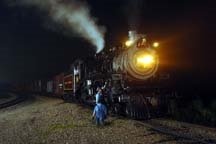
After the coal train departed, Mark Perri and Denis Connell lit up the 1293 a couple more times, and the session ended around midnight with a shot of Grand Trunk Western 4-8-4 No.6325 sitting cold behind the shop.
July 20, 2006
The Ohio Central was again the host for the NRHS as a trip was operated from Dennison to Newark. As was our standard operating practice, we picked up John Dziobko and chased the trip. The first part of the trip found the C420 leading the Amtrak F40, but at Morgan Run both diesels were removed and No.1293 was put on the point for an all-steam trip to Newark. A photo runby was held at Trinway, and as the trip progressed the skies deteriorated. By Newark it was pretty cloudy.
The trip's return was delayed by a meet with a coal train coming out of the power plant at Conesville, requiring the passenger train to hold at Trinway. Since it was stopped anyhow, it was decided to do a photo runby despite the worsening weather conditions. As the train unloaded, rain could be seen comingt in from the west. But it wasn't until lightning struck fairly close by that the runby was cancelled and everyone was put back on the train.
With the steam train sitting at Trinway, we headed to Conesville to find the coal train. We caught it just leaving Conesville and chased it to Dresden, just beyond Trinway (we had a real close encounter with lightning -- a mere 30 yards away hitting a phone pole -- as we shot the train at Adams Mills). Once the train was gone from Dresden, we raced back to overtake the steam train, catching it once at the station at Coshocton before it arrived at Morgan Run and lost its steam engine. With the F40 leading, we shot the train once more at West Lafayette, then headed to Dover to check out the R.J. Corman operation there.

That evening Bruce, Frank, Mike and I (after dinner with other members of the Wilmington [Delaware] Chapter NRHS) went off looking for the Wheeling's rail train, which we hoped would be tied up at Wayco and available for night shots. Alas, it wasn't to be found (which we found out after driving for over an hour), so we drove another hour up to Minerva where we did a night photo session on Ohi-Rail's power sitting around the yard. It was a very late arrival back in New Philadelphia.
July 21, 2006
I needed to be back in New Philadelphia by early afternoon to attend the NRHS business meetings, but Bruce and I met up with Frank and Mike at Brewster where we had a pre-arranged tour of the Wheeling & Lake Erie's shop (where we found the power off the rail train we had been looking for the previous night). We then hung out near Orrville where we hoped to shoot a Brewster-bound freight, but it never showed up (we must have passed it somewhere between Brewster and Orrville). Bruce then hitched a ride with Frank and Mike, while I headed back for New Philadelphia. That evening I attended the banquet where the guest speaker was Ohio Central property manager (and ex-Chessie company photographer) John B. Corns.
July 22, 2006
The final day of the Convention featured a circle trip over the Ohio Central and Wheeling & Lake Erie out of Dennison. Frank and Mike had departed for home, thanks to weather than had been bad since mid-day of the Newark chase. Bruce and I picked up John and off we went in the rain, getting the diesel-powered train with the RS18 leading at West Lafayette.

At Morgan Run the power was run around the train and 4-6-2 No.1293 was added to the point. Just out of Morgan Run, as the train went up the northeastward leg of the triangular trip routing, a photo runby was held (despite the gloomy wet skies) and we caught the train a few more times before it made a stop for the passengers to buy cheese (yes, that's right) at Pearl. At Sugarcreek the steam locomotive was removed and the Orrville Railroad Heritage Society's GP7 led the train into Brewster.
Out of Brewster, with the GP7 still leading, the trip made a
fast run down the Wheeling & Lake Erie on the southeastward leg of the triangle, and we were only able to catch it once on this stretch (thank goodness Pete Swanson and Nick D'Amore were chasing -- they had just missed the train at the spot where we were heading, and if they hadn't been racing out of the location we would have stopped and waited and would probably still be there). At the joint track in Bowerston we caught up with the train as the consist was shuffeld to put the RS18 in the lead for two photo runbys, then it was back to Dennison and the end of the Convention. Talk between the dispatcher and excursion indicated a train would be heading towards Dennison from the west, so we continued eastward and intercepted the train at Newcomerstown. We chased it back through Dennison and on to the big cut at Bowerston before calling it a day.
July 23, 2006
Like the first day of the trip, this last day had the real potential to be quiet. Sadly, that's the way it worked out. We started out by waiting along the joint OC/W&LE track in the morning, hoping to get something. Nothing came. Back to Mingo Junction, and everything was quiet there. I had never been to Benwood Junction, so we checked that out. Quiet. We did find the place where the Wheeling & Lake Erie crosses Norfolk Southern on a diamond in Bellaire, and a dead locomotive in Canadian American paint at Warrenton provided just about all the entertainment we'd get all morning and into the afternoon.
Looking to head east, we headed for Meyersdale, Pennsylvania, where the ex-Western Maryland right-of-way over Salisbury Viaduct is now a bike trail. The bridge provides a panoramic view of the ex-Baltimore & Ohio main line, so we went there hoping to see something on CSX. After waiting over an hour, we got an eastbound train, and a westbound soon came by. Just at sunset, as we were crawling through the brambles back to the car, we heard another eastbound and raced to Meyersdale to shoot it. Sunset marked the end of the trip, save for a long drive home through the darkness on the Pennsylvania Turnpike (which is largely built on the right-of-way of the partially constructed South Penn Railroad -- but that's another story for another time).
Convention Notes
Buckeye Rails 2006 was a largely unspectacular convention by necessity; with no Chapter stepping forward to host the 2006 Convention the event was run by the NRHS National Convention Committee, headed by Carl Jensen. As such, the staff for the event came from all over the U.S., and much of the planning had to be done via e-mail and telephone, with little on-site planning. Therefore, a simple Convention was planned. The other side of the coin is that the Convention was extremely well executed, with no major delays, no bus snafus and no food shortages. Kudos to the Convention staff for pulling off a well-run event despite all the logistical hurdles. Now it's on to Chattanooga for 2007!
 That evening the Cooperstown Blues Express made its run between Milford and Cooperstown, with a live band playing in the gondola and pizza and beer available in the dining car. It was a pleasant evening under the stars. Upon return to Milford, black No.3051 was commandeered for the photo freight, which then headed back north (at 11:00 p.m.!) for more photography at the pond behind Pop's (yours truly and Jeff Smith provided the flash lighting). The night photo session concluded with the train's well-past-midnight arrival back in Milford. I then headed off to a D&H caboose to get some sleep.
That evening the Cooperstown Blues Express made its run between Milford and Cooperstown, with a live band playing in the gondola and pizza and beer available in the dining car. It was a pleasant evening under the stars. Upon return to Milford, black No.3051 was commandeered for the photo freight, which then headed back north (at 11:00 p.m.!) for more photography at the pond behind Pop's (yours truly and Jeff Smith provided the flash lighting). The night photo session concluded with the train's well-past-midnight arrival back in Milford. I then headed off to a D&H caboose to get some sleep. It wasn't long before I heard the engineer reporting to the dispatcher that one engine was dead and another was missing one set of traction motors. This sufficiently slowed the train down on Richmondville Hill that I was able to catch the train a couple of times. A switch thrown against the train at the south end of Richmondville Siding further slowed the train's progress. But once on the downhill side of Richmondville Hill, the train provided a spirited chase. A number of the classic spots were hit, including the D&H signal gantry at Afton. Harpursville Trestle was lit on the north side (a side I hadn't shot before) and the chase ended with sweet light at Belden Tunnel, just ten miles shy of Binghamton. Niced chase!
It wasn't long before I heard the engineer reporting to the dispatcher that one engine was dead and another was missing one set of traction motors. This sufficiently slowed the train down on Richmondville Hill that I was able to catch the train a couple of times. A switch thrown against the train at the south end of Richmondville Siding further slowed the train's progress. But once on the downhill side of Richmondville Hill, the train provided a spirited chase. A number of the classic spots were hit, including the D&H signal gantry at Afton. Harpursville Trestle was lit on the north side (a side I hadn't shot before) and the chase ended with sweet light at Belden Tunnel, just ten miles shy of Binghamton. Niced chase!











